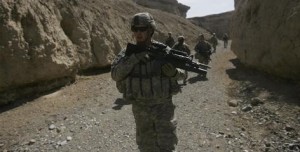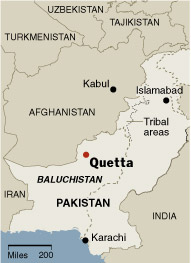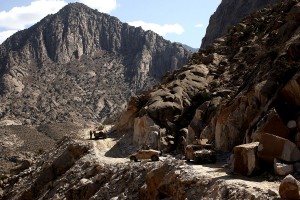The Afghanistan Strategy
BY Herschel SmithThe administration has announced its Afghanistan strategy, parts of which are reproduced below.
Let me start by addressing the way forward in Pakistan. The United States has great respect for the Pakistani people. They have a rich history and have struggled against long odds to sustain their democracy. The people of Pakistan want the same things that we want. An end to terror, access to basic services, the opportunity to live their dreams and the security that can only come with the rule of law. The single greatest threat to that future comes from Al Qaida and their extremist allies. And that is why we must stand together …
So, today, I’m calling upon Congress to pass a bipartisan bill co-sponsored by John Kerry and Richard Lugar that authorizes $1.5 billion in direct support to the Pakistani people every year over the next five years, resources that will build schools, roads, and hospitals, and strengthen Pakistan’s democracy …
Now, we must make a commitment that can accomplish our goals. I’ve already ordered the deployment of 17,000 troops that have been requested by General McKiernan for many months. These soldiers and Marines will take the fight to the Taliban in the south and the east and give us a great capacity to partner with Afghan security forces and to go after insurgents along the border.
This push will also help provide security in advance of the important presidential elections in Afghanistan in August. At the same time, we will shift the emphasis of our mission to training and increasing the size of Afghan security forces so that they can eventually take the lead in securing their country. That’s how we will prepare Afghans to take responsibility for their security and how we will, ultimately, be able to bring our own troops home …
The additional troops that we deployed have already increased our training capacity. And later this spring, we will deploy approximately 4,000 U.S. troops to train Afghan security forces. For the first time, this will truly resource our effort to train and support the Afghan army and police.
Every American unit in Afghanistan will be partnered with an Afghan unit, and we will seek additional trainers from our NATO allies to ensure that every Afghan unit has a coalition partner. We will accelerate our efforts to build an Afghan army of 134,000 and a police for the of 82,000 so that we can meet these goals by 2011 …
At a time of economic crisis, it’s tempting to believe that we can short change the civilian effort. But make no mistake, our efforts will fail in Afghanistan and Pakistan if we don’t invest in their future. And that’s why my budget includes indispensable investments in our State Department and foreign assistance programs.
These investments relieve the burden on our troops. They contribute directly to security. They make the American people safer. And they save us an enormous amount of money in the long run because it’s far cheaper to train a policeman to secure his or her own village that to help a farmer seed a crop or to help a farmer seed a crop than it is to send our troops to fight tour after tour of duty with no transition to Afghan responsibility.
Analysis & Commentary
We fear that this strategy will be disastrous in the superlative degree. Several points are in order prior to summary and conclusion.
- This strategy places too large of a bet on similarities between Americans and Pakistanis. We weighed in concerning the Pakistani elections one year ago amid the celebration among U.S. politicians that the Pakistanis had rejected religious extremism, saying that their analysis missed the point. The elections rejected the incompetence of the official Islamic clerics who had poorly governed the tribal regions, but the party that had been put into power represented what those who were more familiar with Pakistani politics had feared – a voter rejection of the war on terror. The Tehrik-i-Taliban (Taliban of Pakistan) and their supporters boycotted the elections and were untouched by the votes.
- More money is exactly what the Pakistan government wants. As one former Pakistani official told Dexter Filkins, The reason the Pakistani security services support the Taliban, he said, is for money: after the 9/11 attacks, the Pakistani military concluded that keeping the Taliban alive was the surest way to win billions of dollars in aid that Pakistan needed to survive. The military’s complicated relationship with the Taliban is part of what the officialcalled the Pakistani military’s “strategic games.” Like other Pakistanis, this former senior officialspoke on the condition of anonymity because of the sensitivity of what he was telling me. “Pakistan is dependent on the American money that these games with the Taliban generate,” the officialtold me. “The Pakistani economy would collapse without it. This is how the game works.”As an example, he cited the Pakistan Army’s first invasion of the tribal areas — of South Waziristan in 2004. Called Operation Shakai, the offensive was ostensibly aimed at ridding the area of Taliban militants. From an American perspective, the operation was a total failure. The army invaded, fought and then made a deal with one of the militant commanders, Nek Mohammed. The agreement was capped by a dramatic meeting between Mohammed and SafdarHussein, one of the most senior officers in the Pakistan Army.“The corps commander was flown in on a helicopter,” the former official said. “They had this big ceremony, and they embraced. They called each other mujahids. ”“The army agreed to compensate the locals for collateral damage,” the officialsaid. “Where do you think that money went? It went to the Taliban. Who do you think paid the bill? The Americans. This is the way the game works. The Taliban is attacked, but it is never destroyed. “It’s a game,” the official said, wrapping up our conversation. “The U.S. is being taken for a ride.”
- 17,000 troops have not been requested by General McKiernan. This additional force presence meets only around 2/3 of what McKiernan had requested as of February 2009. Furthermore, this request should be seen in the light of the fact that the U.S. Armed Forces in Afghanistan are so under-resourced that contractors are now being sought to provide Forward Operating Base (FOB) force protection. Quite literally, contractors will be used to stand post at FOBs because there aren’t enough troops supporting Operation Enduring Freedom.
- As we have pointed out before, the Afghan National Army is the most trusted institution in Afghanistan, and so the campaign must eventually expand, empower, train and equip the Army to protect the population. The Police aren’t far behind in the trust the population places in it, but there are extreme problems with both corruption and drug abuse (on duty) within the police. The Afghan Army is shot through with drug abuse as well. The campaign has lacked force projection and destruction of the enemy’s power to intimidate the population, and it simply isn’t the time or season for the effort to rely so heavily on indigenous forces.
- We have supported efforts at reconstruction and agricultural assistance, but it must be remembered that agricultural efforts won’t rid the country of Taliban. We’ve pointed out a clever plan to replace poppy and opium as the crop of choice with pomegranates. Asked about the how this plan might affect the Taliban, the proponent said “In the complexity of the tribal system in Afghanistan, the Taliban are in every element of society. When I talked at the three tribal gatherings, the Taliban were present. I believe that if we don’t communicate with every faction of this problem, we’re not going to solve it.” So the plan to replace poppy with pomegranates redounds to fixing Afghanistan as the opium supplier of the world while it continues to strengthen the Taliban because the plan has no parallel line of effort to kill the Taliban.
In a sign of how under-resourced and poorly constructed this plan is, the administration plan was met with praise from both Presidents Zardari and Karzai – Zardari because Pakistan gets the right answer to their query to “show me the money,” and Karzai because he wants international forces to play a secondary role to Afghan forces.
It should be remembered that Karzai has aggressively sought a Status of Forces Agreement similar to the one under which the U.S. currently operates in Iraq. Karzai also happens to be the Afghan President who said to Taliban leader Mullah Omar “My brother, my dear, come back to your homeland. Come back and work for peace, for the good of the Afghan people. Stop this business of brothers killing brothers.”
The Afghan Army and Police aren’t ready for a rapid or massive turnover of authority to them. The government isn’t prepared to be the foundation for these institutions due to the endemic corruption, and the U.S. shouldn’t be ready to settle with any insurgents without first having a fight.
Finally, the most troubling aspect of the administration plan is its failure to address the issue of the Taliban. Al Qaeda is mentioned, but the hosts for AQ training camps receive little attention. In fact, while disparate and factious, the Taliban mission has steadily harmonized over the past few years: to “support the regional war and then the global war against Western hegemony; this is the concept driving the neo-Taliban.”
The globalist jihad movement of al Qaeda has been merged with the Tehrik-i-Taliban of Pakistan. The TTP shout to passersby in Khyber “We are Taliban! We are mujahedin! We are al-Qaida!” There is no distinction. A Pakistan interior ministry official has even said that the TTP and al Qaeda are one and the same.
TTP chief Baitullah Mehsud has said “We want to eradicate Britain and America, and to shatter the arrogance and tyranny of the infidels. We pray that Allah will enable us to destroy the White House, New York, and London.” Now there are even indications that the original Afghan Taliban under Mullah Omar have morphed into an organization that desires regional Islamist revolutions.
There are some indigenous poor who might be able to be stripped away from the hard core Taliban fighters, but the campaign is much more than a counterterrorism operation against some al Qaeda fighters. It is a full blown insurgency that must be defeated with a full orbed counterinsurgency. Anything else won’t do. There still aren’t enough troops in the plan, and it is more likely to cause the diminishing of respect for American troops across the globe than simply withdrawing completely and going back in to topple the next problematic regime.






